BTEC Level 5 Business Environment Unit 1 Assignment Report
VerifiedAdded on 2023/01/05
|20
|5879
|434
Report
AI Summary
This report provides a comprehensive analysis of the business environment, focusing on the different types of organizations: public, private, and voluntary sectors. It explores their purposes, legal structures, sizes, and scopes, linking these elements to business objectives and the products and services offered. The report uses Bearing Point as a case study, examining the interrelationships between organizational functions. It delves into both internal and external factors, employing SWOT and PESTLE analyses to assess strengths, weaknesses, and the impact of macro-environmental influences. The analysis examines the relationships between organizational functions and structures, and the impacts of these interrelationships on business objectives and decision-making. The report concludes with a critical evaluation of the complexities of different business structures and their implications.
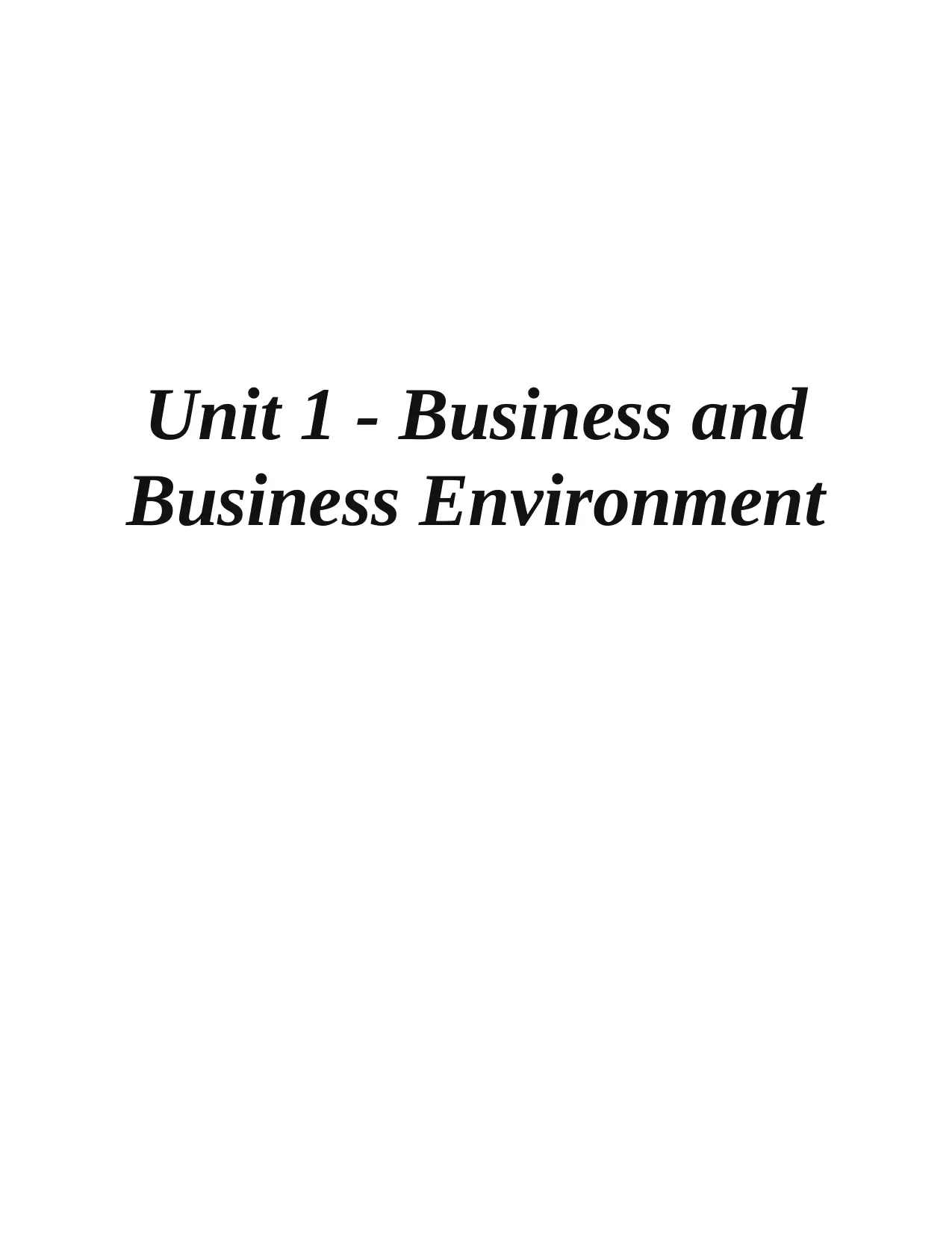
Unit 1 - Business and
Business Environment
Business Environment
Paraphrase This Document
Need a fresh take? Get an instant paraphrase of this document with our AI Paraphraser

Table of Contents
INTRODUCTION ..........................................................................................................................4
TASK 1............................................................................................................................................5
P1 Explain different types and purposes of organisations; public, private and voluntary sectors
and legal structures......................................................................................................................5
P2 Explain the size and scope of a range of different types of organisations.............................7
M1 Analyse how the structure, size and scope of different organisations link to the business
objectives and product and services offered by the organisation................................................9
TASK 2............................................................................................................................................9
P3 Explain the relationship between different organisational functions and how they link to
organisational objectives and structure.......................................................................................9
M2 Analyse the advantages and disadvantages of interrelationships between organisational
functions and the impact that can have upon organisational structure......................................11
D1 Provide a critical analysis of the complexities of different types of business structures and
the interrelationships of the different organisational functions.................................................11
TASK 3..........................................................................................................................................11
P4 Identify the positive and negative impacts the macro environment has upon business
operations, supported by specific examples. / M3 Apply appropriately the PESTLE model to
support a detailed analysis of the macro environment within an organisation.........................11
TASK 4..........................................................................................................................................14
P5 Conduct internal and external analysis of specific organisations in order to identify
strengths and weaknesses..........................................................................................................14
M4 Apply appropriately SWOT/TOWS analysis and justify how they influence decision-
making.......................................................................................................................................15
P6 Explain how strengths and weaknesses interrelate with external macro factors. / D2
Critically evaluate the impacts that both macro and micro factors have upon business
objectives and decision-making................................................................................................15
CONCLUSION .............................................................................................................................17
REFERENCES..............................................................................................................................18
INTRODUCTION ..........................................................................................................................4
TASK 1............................................................................................................................................5
P1 Explain different types and purposes of organisations; public, private and voluntary sectors
and legal structures......................................................................................................................5
P2 Explain the size and scope of a range of different types of organisations.............................7
M1 Analyse how the structure, size and scope of different organisations link to the business
objectives and product and services offered by the organisation................................................9
TASK 2............................................................................................................................................9
P3 Explain the relationship between different organisational functions and how they link to
organisational objectives and structure.......................................................................................9
M2 Analyse the advantages and disadvantages of interrelationships between organisational
functions and the impact that can have upon organisational structure......................................11
D1 Provide a critical analysis of the complexities of different types of business structures and
the interrelationships of the different organisational functions.................................................11
TASK 3..........................................................................................................................................11
P4 Identify the positive and negative impacts the macro environment has upon business
operations, supported by specific examples. / M3 Apply appropriately the PESTLE model to
support a detailed analysis of the macro environment within an organisation.........................11
TASK 4..........................................................................................................................................14
P5 Conduct internal and external analysis of specific organisations in order to identify
strengths and weaknesses..........................................................................................................14
M4 Apply appropriately SWOT/TOWS analysis and justify how they influence decision-
making.......................................................................................................................................15
P6 Explain how strengths and weaknesses interrelate with external macro factors. / D2
Critically evaluate the impacts that both macro and micro factors have upon business
objectives and decision-making................................................................................................15
CONCLUSION .............................................................................................................................17
REFERENCES..............................................................................................................................18
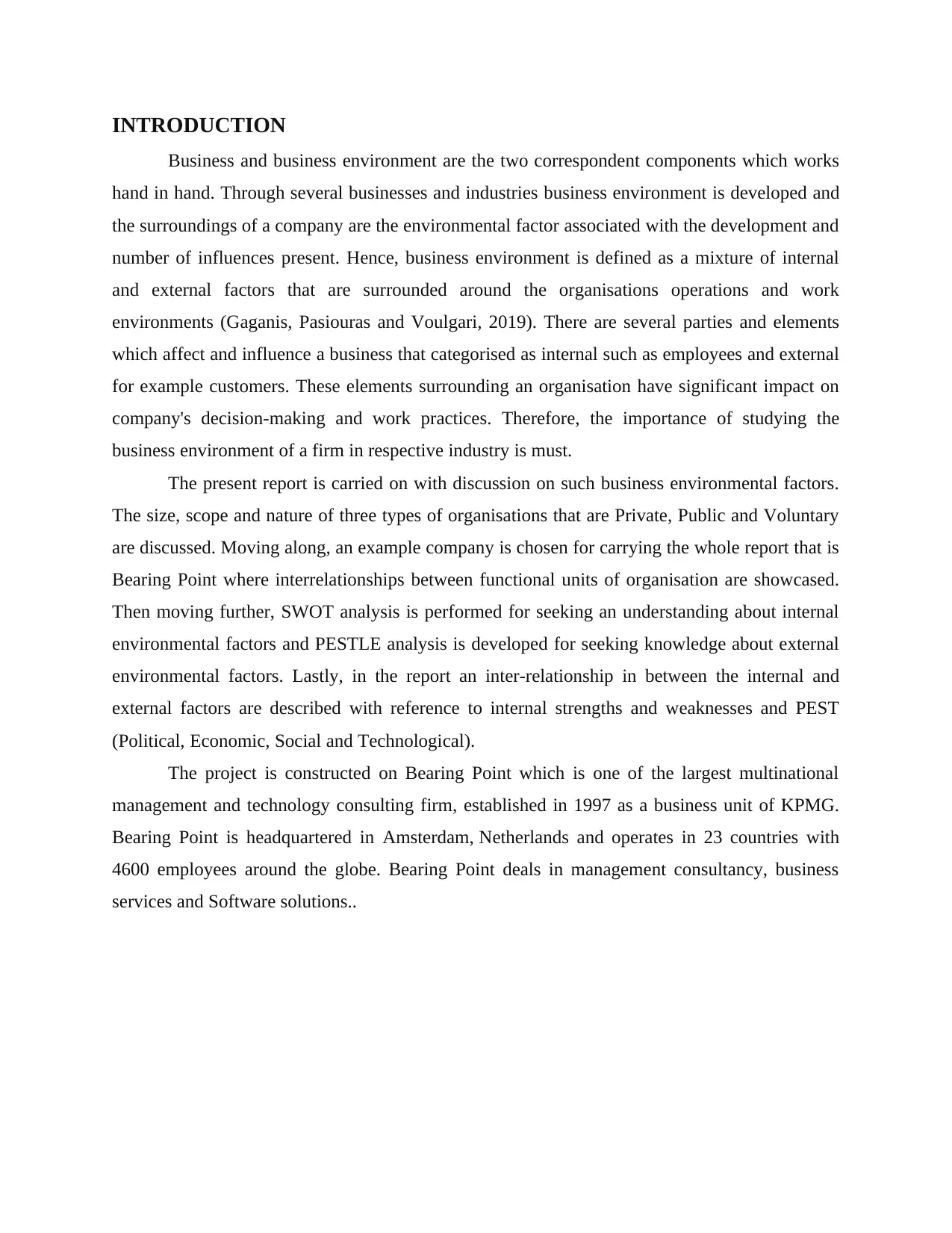
INTRODUCTION
Business and business environment are the two correspondent components which works
hand in hand. Through several businesses and industries business environment is developed and
the surroundings of a company are the environmental factor associated with the development and
number of influences present. Hence, business environment is defined as a mixture of internal
and external factors that are surrounded around the organisations operations and work
environments (Gaganis, Pasiouras and Voulgari, 2019). There are several parties and elements
which affect and influence a business that categorised as internal such as employees and external
for example customers. These elements surrounding an organisation have significant impact on
company's decision-making and work practices. Therefore, the importance of studying the
business environment of a firm in respective industry is must.
The present report is carried on with discussion on such business environmental factors.
The size, scope and nature of three types of organisations that are Private, Public and Voluntary
are discussed. Moving along, an example company is chosen for carrying the whole report that is
Bearing Point where interrelationships between functional units of organisation are showcased.
Then moving further, SWOT analysis is performed for seeking an understanding about internal
environmental factors and PESTLE analysis is developed for seeking knowledge about external
environmental factors. Lastly, in the report an inter-relationship in between the internal and
external factors are described with reference to internal strengths and weaknesses and PEST
(Political, Economic, Social and Technological).
The project is constructed on Bearing Point which is one of the largest multinational
management and technology consulting firm, established in 1997 as a business unit of KPMG.
Bearing Point is headquartered in Amsterdam, Netherlands and operates in 23 countries with
4600 employees around the globe. Bearing Point deals in management consultancy, business
services and Software solutions..
Business and business environment are the two correspondent components which works
hand in hand. Through several businesses and industries business environment is developed and
the surroundings of a company are the environmental factor associated with the development and
number of influences present. Hence, business environment is defined as a mixture of internal
and external factors that are surrounded around the organisations operations and work
environments (Gaganis, Pasiouras and Voulgari, 2019). There are several parties and elements
which affect and influence a business that categorised as internal such as employees and external
for example customers. These elements surrounding an organisation have significant impact on
company's decision-making and work practices. Therefore, the importance of studying the
business environment of a firm in respective industry is must.
The present report is carried on with discussion on such business environmental factors.
The size, scope and nature of three types of organisations that are Private, Public and Voluntary
are discussed. Moving along, an example company is chosen for carrying the whole report that is
Bearing Point where interrelationships between functional units of organisation are showcased.
Then moving further, SWOT analysis is performed for seeking an understanding about internal
environmental factors and PESTLE analysis is developed for seeking knowledge about external
environmental factors. Lastly, in the report an inter-relationship in between the internal and
external factors are described with reference to internal strengths and weaknesses and PEST
(Political, Economic, Social and Technological).
The project is constructed on Bearing Point which is one of the largest multinational
management and technology consulting firm, established in 1997 as a business unit of KPMG.
Bearing Point is headquartered in Amsterdam, Netherlands and operates in 23 countries with
4600 employees around the globe. Bearing Point deals in management consultancy, business
services and Software solutions..
⊘ This is a preview!⊘
Do you want full access?
Subscribe today to unlock all pages.

Trusted by 1+ million students worldwide
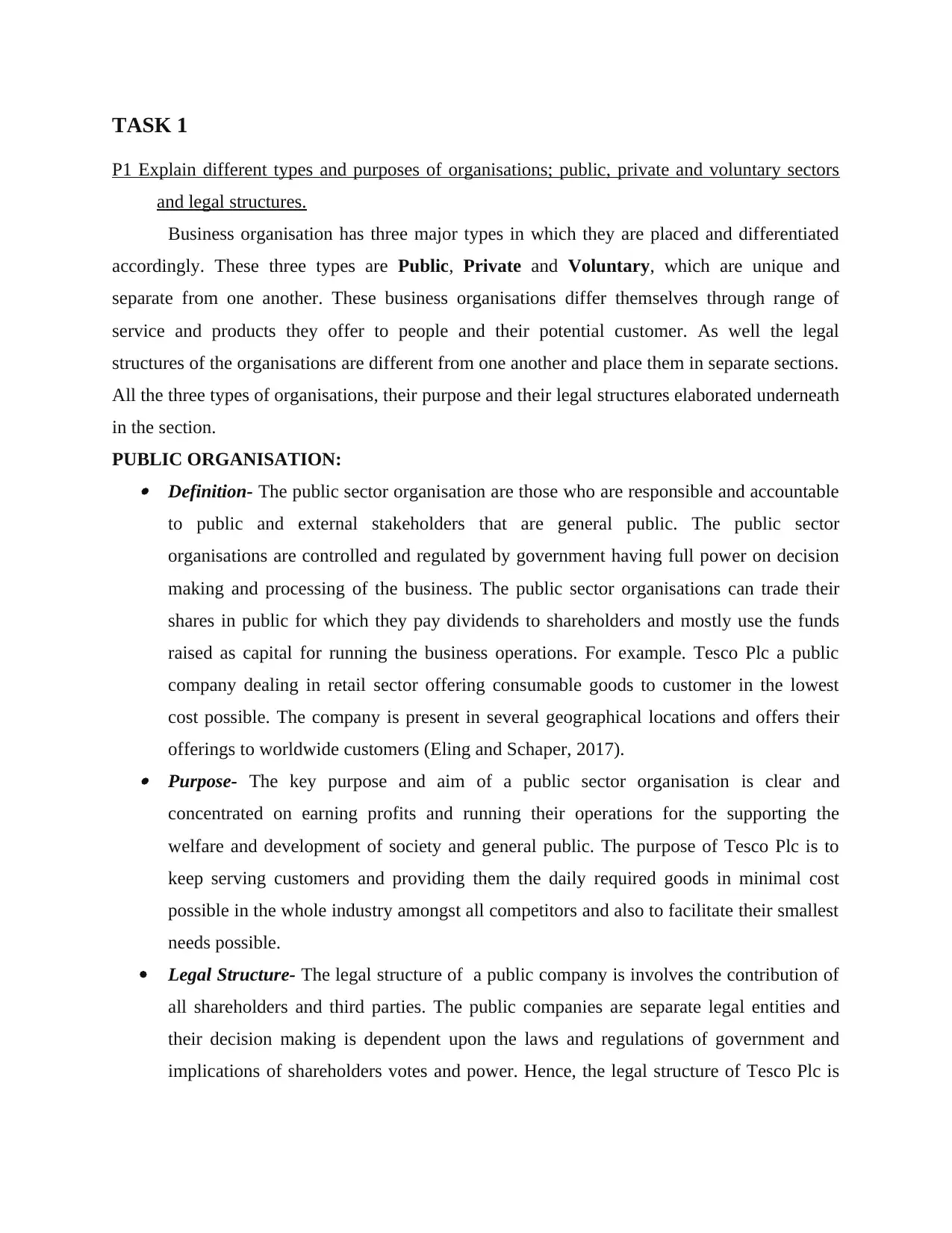
TASK 1
P1 Explain different types and purposes of organisations; public, private and voluntary sectors
and legal structures.
Business organisation has three major types in which they are placed and differentiated
accordingly. These three types are Public, Private and Voluntary, which are unique and
separate from one another. These business organisations differ themselves through range of
service and products they offer to people and their potential customer. As well the legal
structures of the organisations are different from one another and place them in separate sections.
All the three types of organisations, their purpose and their legal structures elaborated underneath
in the section.
PUBLIC ORGANISATION: Definition- The public sector organisation are those who are responsible and accountable
to public and external stakeholders that are general public. The public sector
organisations are controlled and regulated by government having full power on decision
making and processing of the business. The public sector organisations can trade their
shares in public for which they pay dividends to shareholders and mostly use the funds
raised as capital for running the business operations. For example. Tesco Plc a public
company dealing in retail sector offering consumable goods to customer in the lowest
cost possible. The company is present in several geographical locations and offers their
offerings to worldwide customers (Eling and Schaper, 2017). Purpose- The key purpose and aim of a public sector organisation is clear and
concentrated on earning profits and running their operations for the supporting the
welfare and development of society and general public. The purpose of Tesco Plc is to
keep serving customers and providing them the daily required goods in minimal cost
possible in the whole industry amongst all competitors and also to facilitate their smallest
needs possible.
Legal Structure- The legal structure of a public company is involves the contribution of
all shareholders and third parties. The public companies are separate legal entities and
their decision making is dependent upon the laws and regulations of government and
implications of shareholders votes and power. Hence, the legal structure of Tesco Plc is
P1 Explain different types and purposes of organisations; public, private and voluntary sectors
and legal structures.
Business organisation has three major types in which they are placed and differentiated
accordingly. These three types are Public, Private and Voluntary, which are unique and
separate from one another. These business organisations differ themselves through range of
service and products they offer to people and their potential customer. As well the legal
structures of the organisations are different from one another and place them in separate sections.
All the three types of organisations, their purpose and their legal structures elaborated underneath
in the section.
PUBLIC ORGANISATION: Definition- The public sector organisation are those who are responsible and accountable
to public and external stakeholders that are general public. The public sector
organisations are controlled and regulated by government having full power on decision
making and processing of the business. The public sector organisations can trade their
shares in public for which they pay dividends to shareholders and mostly use the funds
raised as capital for running the business operations. For example. Tesco Plc a public
company dealing in retail sector offering consumable goods to customer in the lowest
cost possible. The company is present in several geographical locations and offers their
offerings to worldwide customers (Eling and Schaper, 2017). Purpose- The key purpose and aim of a public sector organisation is clear and
concentrated on earning profits and running their operations for the supporting the
welfare and development of society and general public. The purpose of Tesco Plc is to
keep serving customers and providing them the daily required goods in minimal cost
possible in the whole industry amongst all competitors and also to facilitate their smallest
needs possible.
Legal Structure- The legal structure of a public company is involves the contribution of
all shareholders and third parties. The public companies are separate legal entities and
their decision making is dependent upon the laws and regulations of government and
implications of shareholders votes and power. Hence, the legal structure of Tesco Plc is
Paraphrase This Document
Need a fresh take? Get an instant paraphrase of this document with our AI Paraphraser
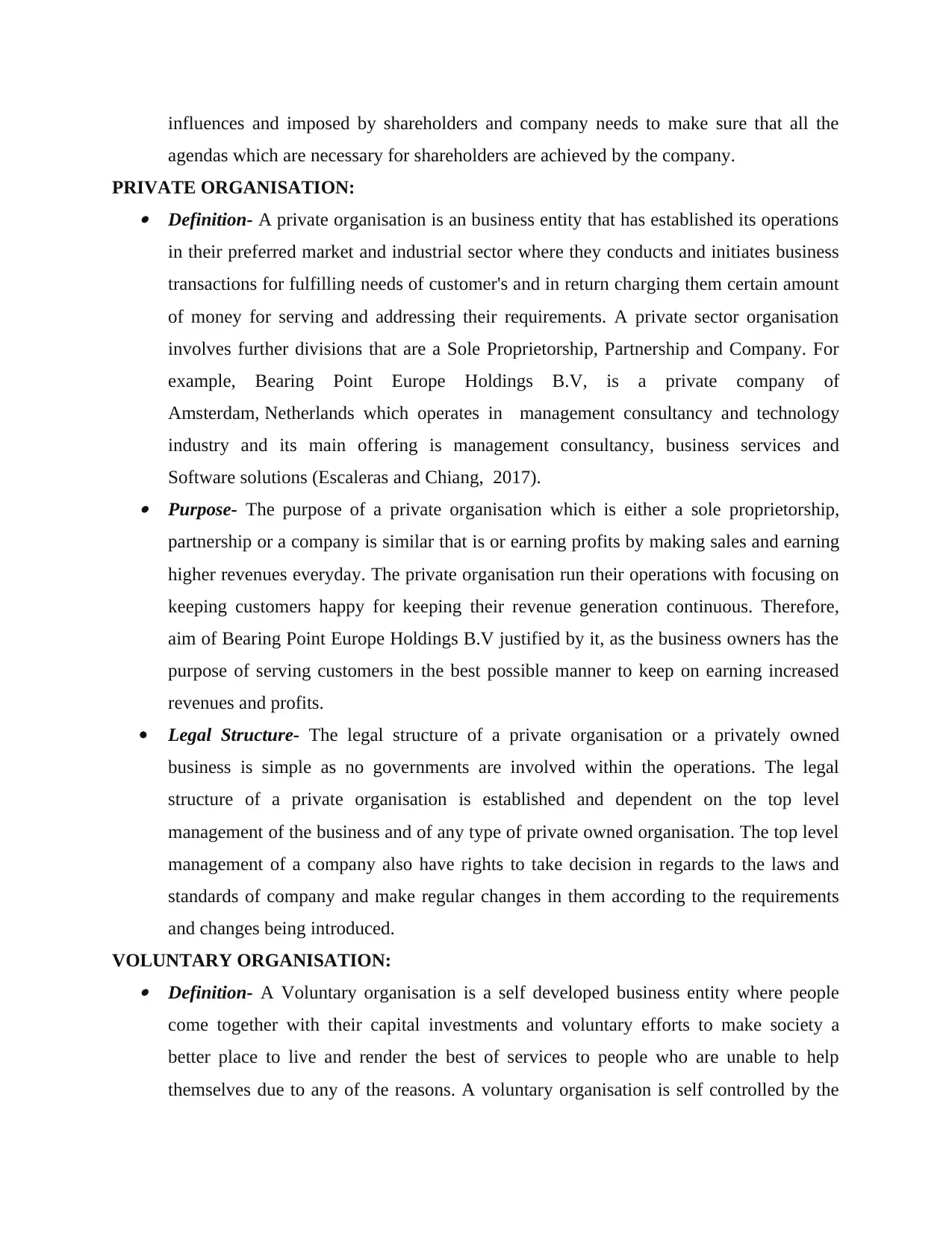
influences and imposed by shareholders and company needs to make sure that all the
agendas which are necessary for shareholders are achieved by the company.
PRIVATE ORGANISATION: Definition- A private organisation is an business entity that has established its operations
in their preferred market and industrial sector where they conducts and initiates business
transactions for fulfilling needs of customer's and in return charging them certain amount
of money for serving and addressing their requirements. A private sector organisation
involves further divisions that are a Sole Proprietorship, Partnership and Company. For
example, Bearing Point Europe Holdings B.V, is a private company of
Amsterdam, Netherlands which operates in management consultancy and technology
industry and its main offering is management consultancy, business services and
Software solutions (Escaleras and Chiang, 2017). Purpose- The purpose of a private organisation which is either a sole proprietorship,
partnership or a company is similar that is or earning profits by making sales and earning
higher revenues everyday. The private organisation run their operations with focusing on
keeping customers happy for keeping their revenue generation continuous. Therefore,
aim of Bearing Point Europe Holdings B.V justified by it, as the business owners has the
purpose of serving customers in the best possible manner to keep on earning increased
revenues and profits.
Legal Structure- The legal structure of a private organisation or a privately owned
business is simple as no governments are involved within the operations. The legal
structure of a private organisation is established and dependent on the top level
management of the business and of any type of private owned organisation. The top level
management of a company also have rights to take decision in regards to the laws and
standards of company and make regular changes in them according to the requirements
and changes being introduced.
VOLUNTARY ORGANISATION: Definition- A Voluntary organisation is a self developed business entity where people
come together with their capital investments and voluntary efforts to make society a
better place to live and render the best of services to people who are unable to help
themselves due to any of the reasons. A voluntary organisation is self controlled by the
agendas which are necessary for shareholders are achieved by the company.
PRIVATE ORGANISATION: Definition- A private organisation is an business entity that has established its operations
in their preferred market and industrial sector where they conducts and initiates business
transactions for fulfilling needs of customer's and in return charging them certain amount
of money for serving and addressing their requirements. A private sector organisation
involves further divisions that are a Sole Proprietorship, Partnership and Company. For
example, Bearing Point Europe Holdings B.V, is a private company of
Amsterdam, Netherlands which operates in management consultancy and technology
industry and its main offering is management consultancy, business services and
Software solutions (Escaleras and Chiang, 2017). Purpose- The purpose of a private organisation which is either a sole proprietorship,
partnership or a company is similar that is or earning profits by making sales and earning
higher revenues everyday. The private organisation run their operations with focusing on
keeping customers happy for keeping their revenue generation continuous. Therefore,
aim of Bearing Point Europe Holdings B.V justified by it, as the business owners has the
purpose of serving customers in the best possible manner to keep on earning increased
revenues and profits.
Legal Structure- The legal structure of a private organisation or a privately owned
business is simple as no governments are involved within the operations. The legal
structure of a private organisation is established and dependent on the top level
management of the business and of any type of private owned organisation. The top level
management of a company also have rights to take decision in regards to the laws and
standards of company and make regular changes in them according to the requirements
and changes being introduced.
VOLUNTARY ORGANISATION: Definition- A Voluntary organisation is a self developed business entity where people
come together with their capital investments and voluntary efforts to make society a
better place to live and render the best of services to people who are unable to help
themselves due to any of the reasons. A voluntary organisation is self controlled by the
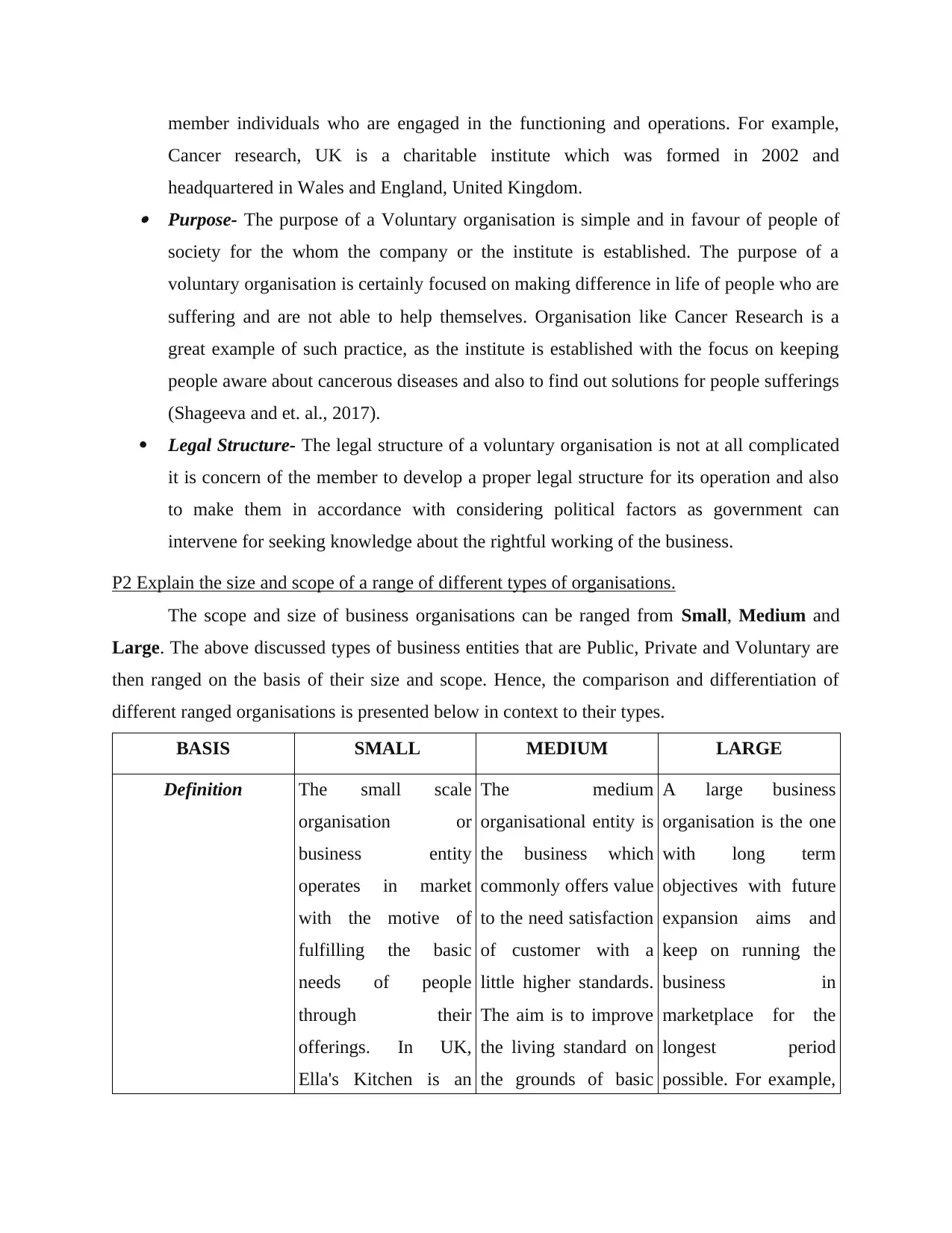
member individuals who are engaged in the functioning and operations. For example,
Cancer research, UK is a charitable institute which was formed in 2002 and
headquartered in Wales and England, United Kingdom. Purpose- The purpose of a Voluntary organisation is simple and in favour of people of
society for the whom the company or the institute is established. The purpose of a
voluntary organisation is certainly focused on making difference in life of people who are
suffering and are not able to help themselves. Organisation like Cancer Research is a
great example of such practice, as the institute is established with the focus on keeping
people aware about cancerous diseases and also to find out solutions for people sufferings
(Shageeva and et. al., 2017).
Legal Structure- The legal structure of a voluntary organisation is not at all complicated
it is concern of the member to develop a proper legal structure for its operation and also
to make them in accordance with considering political factors as government can
intervene for seeking knowledge about the rightful working of the business.
P2 Explain the size and scope of a range of different types of organisations.
The scope and size of business organisations can be ranged from Small, Medium and
Large. The above discussed types of business entities that are Public, Private and Voluntary are
then ranged on the basis of their size and scope. Hence, the comparison and differentiation of
different ranged organisations is presented below in context to their types.
BASIS SMALL MEDIUM LARGE
Definition The small scale
organisation or
business entity
operates in market
with the motive of
fulfilling the basic
needs of people
through their
offerings. In UK,
Ella's Kitchen is an
The medium
organisational entity is
the business which
commonly offers value
to the need satisfaction
of customer with a
little higher standards.
The aim is to improve
the living standard on
the grounds of basic
A large business
organisation is the one
with long term
objectives with future
expansion aims and
keep on running the
business in
marketplace for the
longest period
possible. For example,
Cancer research, UK is a charitable institute which was formed in 2002 and
headquartered in Wales and England, United Kingdom. Purpose- The purpose of a Voluntary organisation is simple and in favour of people of
society for the whom the company or the institute is established. The purpose of a
voluntary organisation is certainly focused on making difference in life of people who are
suffering and are not able to help themselves. Organisation like Cancer Research is a
great example of such practice, as the institute is established with the focus on keeping
people aware about cancerous diseases and also to find out solutions for people sufferings
(Shageeva and et. al., 2017).
Legal Structure- The legal structure of a voluntary organisation is not at all complicated
it is concern of the member to develop a proper legal structure for its operation and also
to make them in accordance with considering political factors as government can
intervene for seeking knowledge about the rightful working of the business.
P2 Explain the size and scope of a range of different types of organisations.
The scope and size of business organisations can be ranged from Small, Medium and
Large. The above discussed types of business entities that are Public, Private and Voluntary are
then ranged on the basis of their size and scope. Hence, the comparison and differentiation of
different ranged organisations is presented below in context to their types.
BASIS SMALL MEDIUM LARGE
Definition The small scale
organisation or
business entity
operates in market
with the motive of
fulfilling the basic
needs of people
through their
offerings. In UK,
Ella's Kitchen is an
The medium
organisational entity is
the business which
commonly offers value
to the need satisfaction
of customer with a
little higher standards.
The aim is to improve
the living standard on
the grounds of basic
A large business
organisation is the one
with long term
objectives with future
expansion aims and
keep on running the
business in
marketplace for the
longest period
possible. For example,
⊘ This is a preview!⊘
Do you want full access?
Subscribe today to unlock all pages.

Trusted by 1+ million students worldwide

example of a small
business entity.
profit. For example, in
UK a medium sized
business is Smith
Brothers.
Bearing Point Europe
Holdings B.V is a
large organisation
which is serving to
multiple customer's
worldwide and also
plans to expand
further.
Size The size of a small
business organisation
is dependent on their
employee size and
turnover that is
between 0-10.
In medium sized
business the total
number of workers is
between 50 to 249 as
these are necessary for
running the business
effectively (Mbaye
and Gueye, 2018).
In large organisations
the number includes
more than 250
employees.
Scope The scope of a small
size business is to
have appropriate
opportunity to deal
and survive at the local
market where they are
running their
operations.
The medium sized
businesses are
commonly family
owned and are
managed by their
virtue size. The
ownership of a
medium sized business
is separated from
management.
The large businesses
are complex in nature
and also have great
number of business
operations on the daily
basis. Hence, the
scope of large
organisations is huge
as their numbers of
customers are large
and they have great
volume of business
communication and
contacts.
business entity.
profit. For example, in
UK a medium sized
business is Smith
Brothers.
Bearing Point Europe
Holdings B.V is a
large organisation
which is serving to
multiple customer's
worldwide and also
plans to expand
further.
Size The size of a small
business organisation
is dependent on their
employee size and
turnover that is
between 0-10.
In medium sized
business the total
number of workers is
between 50 to 249 as
these are necessary for
running the business
effectively (Mbaye
and Gueye, 2018).
In large organisations
the number includes
more than 250
employees.
Scope The scope of a small
size business is to
have appropriate
opportunity to deal
and survive at the local
market where they are
running their
operations.
The medium sized
businesses are
commonly family
owned and are
managed by their
virtue size. The
ownership of a
medium sized business
is separated from
management.
The large businesses
are complex in nature
and also have great
number of business
operations on the daily
basis. Hence, the
scope of large
organisations is huge
as their numbers of
customers are large
and they have great
volume of business
communication and
contacts.
Paraphrase This Document
Need a fresh take? Get an instant paraphrase of this document with our AI Paraphraser
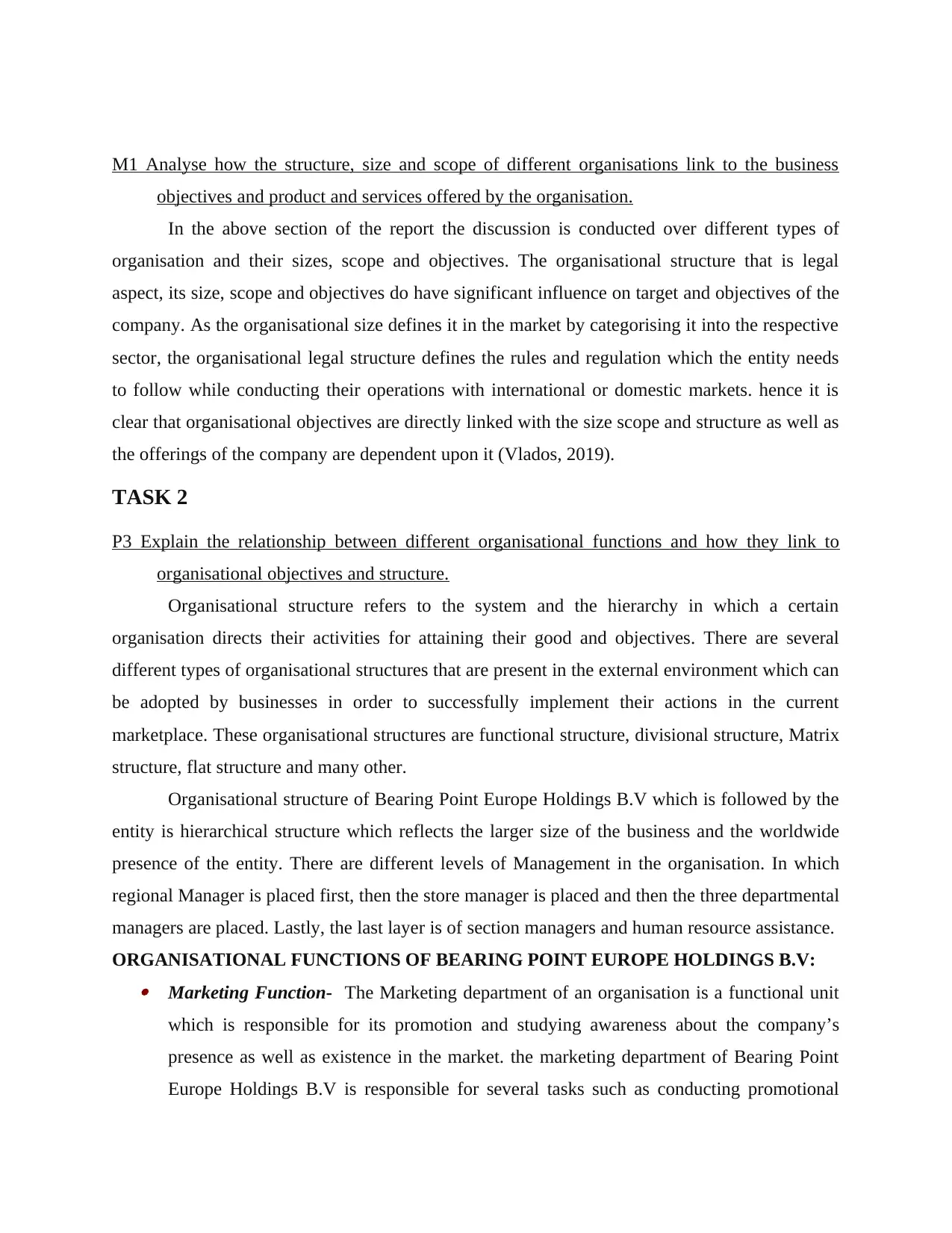
M1 Analyse how the structure, size and scope of different organisations link to the business
objectives and product and services offered by the organisation.
In the above section of the report the discussion is conducted over different types of
organisation and their sizes, scope and objectives. The organisational structure that is legal
aspect, its size, scope and objectives do have significant influence on target and objectives of the
company. As the organisational size defines it in the market by categorising it into the respective
sector, the organisational legal structure defines the rules and regulation which the entity needs
to follow while conducting their operations with international or domestic markets. hence it is
clear that organisational objectives are directly linked with the size scope and structure as well as
the offerings of the company are dependent upon it (Vlados, 2019).
TASK 2
P3 Explain the relationship between different organisational functions and how they link to
organisational objectives and structure.
Organisational structure refers to the system and the hierarchy in which a certain
organisation directs their activities for attaining their good and objectives. There are several
different types of organisational structures that are present in the external environment which can
be adopted by businesses in order to successfully implement their actions in the current
marketplace. These organisational structures are functional structure, divisional structure, Matrix
structure, flat structure and many other.
Organisational structure of Bearing Point Europe Holdings B.V which is followed by the
entity is hierarchical structure which reflects the larger size of the business and the worldwide
presence of the entity. There are different levels of Management in the organisation. In which
regional Manager is placed first, then the store manager is placed and then the three departmental
managers are placed. Lastly, the last layer is of section managers and human resource assistance.
ORGANISATIONAL FUNCTIONS OF BEARING POINT EUROPE HOLDINGS B.V: Marketing Function- The Marketing department of an organisation is a functional unit
which is responsible for its promotion and studying awareness about the company’s
presence as well as existence in the market. the marketing department of Bearing Point
Europe Holdings B.V is responsible for several tasks such as conducting promotional
objectives and product and services offered by the organisation.
In the above section of the report the discussion is conducted over different types of
organisation and their sizes, scope and objectives. The organisational structure that is legal
aspect, its size, scope and objectives do have significant influence on target and objectives of the
company. As the organisational size defines it in the market by categorising it into the respective
sector, the organisational legal structure defines the rules and regulation which the entity needs
to follow while conducting their operations with international or domestic markets. hence it is
clear that organisational objectives are directly linked with the size scope and structure as well as
the offerings of the company are dependent upon it (Vlados, 2019).
TASK 2
P3 Explain the relationship between different organisational functions and how they link to
organisational objectives and structure.
Organisational structure refers to the system and the hierarchy in which a certain
organisation directs their activities for attaining their good and objectives. There are several
different types of organisational structures that are present in the external environment which can
be adopted by businesses in order to successfully implement their actions in the current
marketplace. These organisational structures are functional structure, divisional structure, Matrix
structure, flat structure and many other.
Organisational structure of Bearing Point Europe Holdings B.V which is followed by the
entity is hierarchical structure which reflects the larger size of the business and the worldwide
presence of the entity. There are different levels of Management in the organisation. In which
regional Manager is placed first, then the store manager is placed and then the three departmental
managers are placed. Lastly, the last layer is of section managers and human resource assistance.
ORGANISATIONAL FUNCTIONS OF BEARING POINT EUROPE HOLDINGS B.V: Marketing Function- The Marketing department of an organisation is a functional unit
which is responsible for its promotion and studying awareness about the company’s
presence as well as existence in the market. the marketing department of Bearing Point
Europe Holdings B.V is responsible for several tasks such as conducting promotional
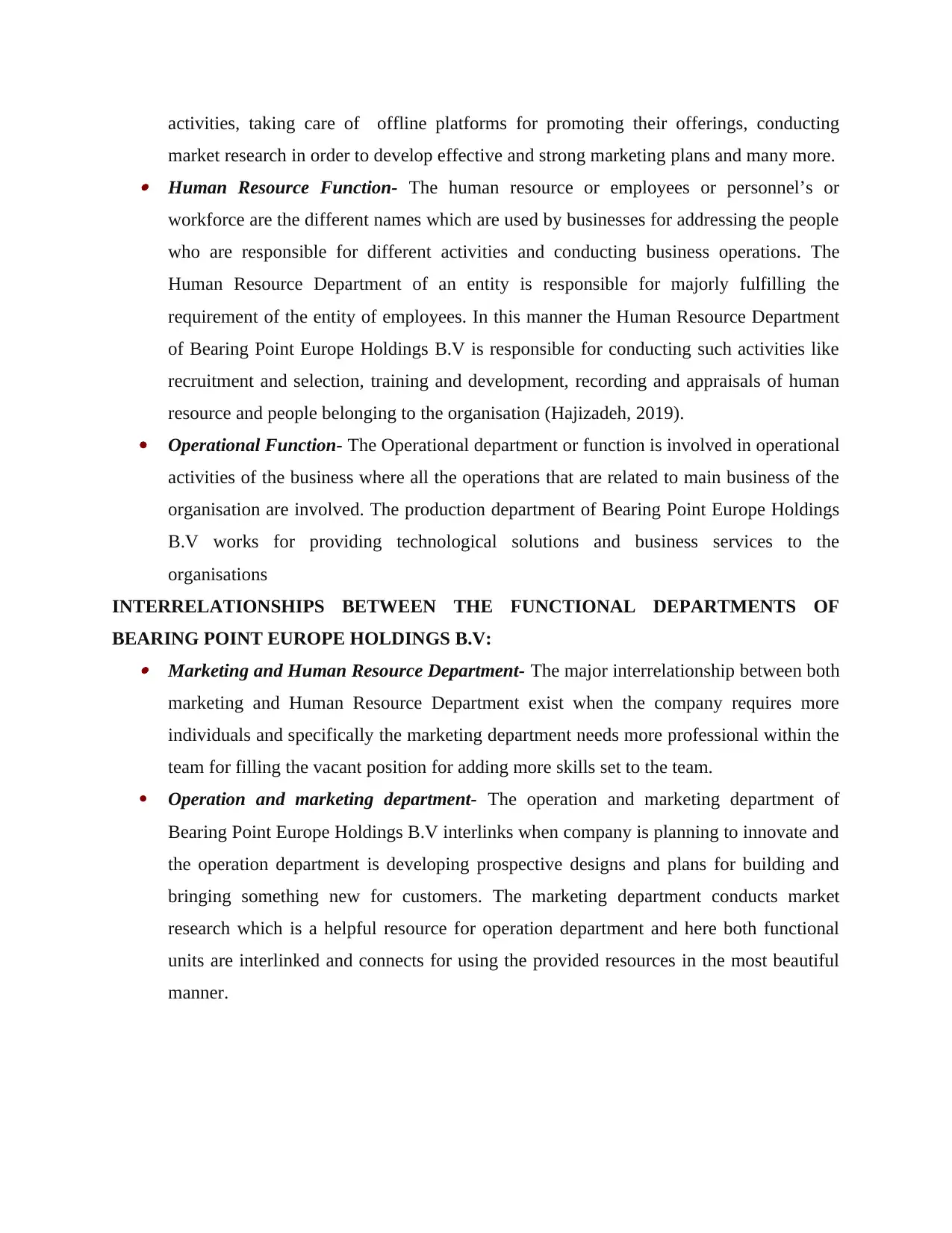
activities, taking care of offline platforms for promoting their offerings, conducting
market research in order to develop effective and strong marketing plans and many more. Human Resource Function- The human resource or employees or personnel’s or
workforce are the different names which are used by businesses for addressing the people
who are responsible for different activities and conducting business operations. The
Human Resource Department of an entity is responsible for majorly fulfilling the
requirement of the entity of employees. In this manner the Human Resource Department
of Bearing Point Europe Holdings B.V is responsible for conducting such activities like
recruitment and selection, training and development, recording and appraisals of human
resource and people belonging to the organisation (Hajizadeh, 2019).
Operational Function- The Operational department or function is involved in operational
activities of the business where all the operations that are related to main business of the
organisation are involved. The production department of Bearing Point Europe Holdings
B.V works for providing technological solutions and business services to the
organisations
INTERRELATIONSHIPS BETWEEN THE FUNCTIONAL DEPARTMENTS OF
BEARING POINT EUROPE HOLDINGS B.V: Marketing and Human Resource Department- The major interrelationship between both
marketing and Human Resource Department exist when the company requires more
individuals and specifically the marketing department needs more professional within the
team for filling the vacant position for adding more skills set to the team.
Operation and marketing department- The operation and marketing department of
Bearing Point Europe Holdings B.V interlinks when company is planning to innovate and
the operation department is developing prospective designs and plans for building and
bringing something new for customers. The marketing department conducts market
research which is a helpful resource for operation department and here both functional
units are interlinked and connects for using the provided resources in the most beautiful
manner.
market research in order to develop effective and strong marketing plans and many more. Human Resource Function- The human resource or employees or personnel’s or
workforce are the different names which are used by businesses for addressing the people
who are responsible for different activities and conducting business operations. The
Human Resource Department of an entity is responsible for majorly fulfilling the
requirement of the entity of employees. In this manner the Human Resource Department
of Bearing Point Europe Holdings B.V is responsible for conducting such activities like
recruitment and selection, training and development, recording and appraisals of human
resource and people belonging to the organisation (Hajizadeh, 2019).
Operational Function- The Operational department or function is involved in operational
activities of the business where all the operations that are related to main business of the
organisation are involved. The production department of Bearing Point Europe Holdings
B.V works for providing technological solutions and business services to the
organisations
INTERRELATIONSHIPS BETWEEN THE FUNCTIONAL DEPARTMENTS OF
BEARING POINT EUROPE HOLDINGS B.V: Marketing and Human Resource Department- The major interrelationship between both
marketing and Human Resource Department exist when the company requires more
individuals and specifically the marketing department needs more professional within the
team for filling the vacant position for adding more skills set to the team.
Operation and marketing department- The operation and marketing department of
Bearing Point Europe Holdings B.V interlinks when company is planning to innovate and
the operation department is developing prospective designs and plans for building and
bringing something new for customers. The marketing department conducts market
research which is a helpful resource for operation department and here both functional
units are interlinked and connects for using the provided resources in the most beautiful
manner.
⊘ This is a preview!⊘
Do you want full access?
Subscribe today to unlock all pages.

Trusted by 1+ million students worldwide

M2 Analyse the advantages and disadvantages of interrelationships between organisational
functions and the impact that can have upon organisational structure.
In an organisation the functional units are interlinked and dependent on one another for
conducting their assigned tasks and fulfilling the given objective in order to contribute to the
ultimate objectives of the business. In the same manner there are different functional units of
Bearing Point Europe Holdings B.V which are interrelated and these relationships do have
certain advantages and disadvantages. The most common advantage of interrelated businesses is
the increased productivity of operations as well as functional units of the business. On the other
hand the disadvantage is higher dependency of functional units on one another which sometimes
affect their performance.
D1 Provide a critical analysis of the complexities of different types of business structures and the
interrelationships of the different organisational functions.
There are different business organisational structures which are used by entities
according to their objectives, sizes and scope. Hence it is proved that all the organisational
structures are separated and renders unique benefits to the company. Sometimes these
organisational structures creates complexities for business operations to enter link and work
together. Such as if Bearing Point would be using divisional structure it would be difficult for
different departments belonging to different geographical areas to be connected with one another
creating a complexity for the business and operational activities (Stoyanova and Harizanova-
Bartos, 2017).
TASK 3
P4 Identify the positive and negative impacts the macro environment has upon business
operations, supported by specific examples. / M3 Apply appropriately the PESTLE model
to support a detailed analysis of the macro environment within an organisation.
For evaluating and studying the external environment of Bearing Point Europe Holdings
B.V, PESTLE analysis is the tool which is used as it helps in seeking thorough understanding
and monitoring the macro environmental factors which may impact the performance of the
organisation. The PESTLE is a tool which is applicable to external analysis and used for the
purpose of knowing the elements which are risky or profitable and have long term impact on the
business. The PESTLE is abbreviated as Political, Economic, Social, Technological, Legal and
functions and the impact that can have upon organisational structure.
In an organisation the functional units are interlinked and dependent on one another for
conducting their assigned tasks and fulfilling the given objective in order to contribute to the
ultimate objectives of the business. In the same manner there are different functional units of
Bearing Point Europe Holdings B.V which are interrelated and these relationships do have
certain advantages and disadvantages. The most common advantage of interrelated businesses is
the increased productivity of operations as well as functional units of the business. On the other
hand the disadvantage is higher dependency of functional units on one another which sometimes
affect their performance.
D1 Provide a critical analysis of the complexities of different types of business structures and the
interrelationships of the different organisational functions.
There are different business organisational structures which are used by entities
according to their objectives, sizes and scope. Hence it is proved that all the organisational
structures are separated and renders unique benefits to the company. Sometimes these
organisational structures creates complexities for business operations to enter link and work
together. Such as if Bearing Point would be using divisional structure it would be difficult for
different departments belonging to different geographical areas to be connected with one another
creating a complexity for the business and operational activities (Stoyanova and Harizanova-
Bartos, 2017).
TASK 3
P4 Identify the positive and negative impacts the macro environment has upon business
operations, supported by specific examples. / M3 Apply appropriately the PESTLE model
to support a detailed analysis of the macro environment within an organisation.
For evaluating and studying the external environment of Bearing Point Europe Holdings
B.V, PESTLE analysis is the tool which is used as it helps in seeking thorough understanding
and monitoring the macro environmental factors which may impact the performance of the
organisation. The PESTLE is a tool which is applicable to external analysis and used for the
purpose of knowing the elements which are risky or profitable and have long term impact on the
business. The PESTLE is abbreviated as Political, Economic, Social, Technological, Legal and
Paraphrase This Document
Need a fresh take? Get an instant paraphrase of this document with our AI Paraphraser
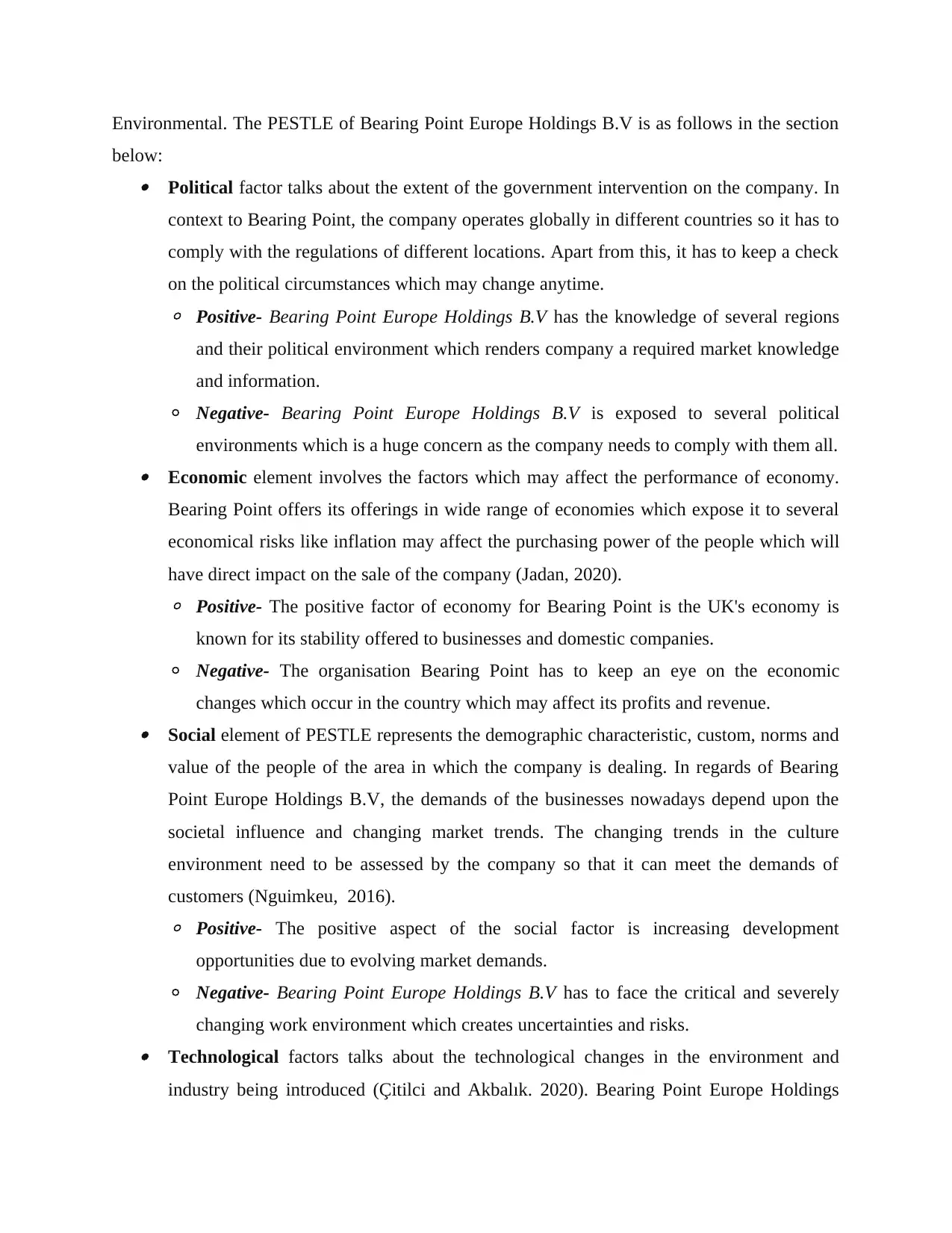
Environmental. The PESTLE of Bearing Point Europe Holdings B.V is as follows in the section
below: Political factor talks about the extent of the government intervention on the company. In
context to Bearing Point, the company operates globally in different countries so it has to
comply with the regulations of different locations. Apart from this, it has to keep a check
on the political circumstances which may change anytime.
◦ Positive- Bearing Point Europe Holdings B.V has the knowledge of several regions
and their political environment which renders company a required market knowledge
and information.
◦ Negative- Bearing Point Europe Holdings B.V is exposed to several political
environments which is a huge concern as the company needs to comply with them all. Economic element involves the factors which may affect the performance of economy.
Bearing Point offers its offerings in wide range of economies which expose it to several
economical risks like inflation may affect the purchasing power of the people which will
have direct impact on the sale of the company (Jadan, 2020).
◦ Positive- The positive factor of economy for Bearing Point is the UK's economy is
known for its stability offered to businesses and domestic companies.
◦ Negative- The organisation Bearing Point has to keep an eye on the economic
changes which occur in the country which may affect its profits and revenue. Social element of PESTLE represents the demographic characteristic, custom, norms and
value of the people of the area in which the company is dealing. In regards of Bearing
Point Europe Holdings B.V, the demands of the businesses nowadays depend upon the
societal influence and changing market trends. The changing trends in the culture
environment need to be assessed by the company so that it can meet the demands of
customers (Nguimkeu, 2016).
◦ Positive- The positive aspect of the social factor is increasing development
opportunities due to evolving market demands.
◦ Negative- Bearing Point Europe Holdings B.V has to face the critical and severely
changing work environment which creates uncertainties and risks. Technological factors talks about the technological changes in the environment and
industry being introduced (Çitilci and Akbalık. 2020). Bearing Point Europe Holdings
below: Political factor talks about the extent of the government intervention on the company. In
context to Bearing Point, the company operates globally in different countries so it has to
comply with the regulations of different locations. Apart from this, it has to keep a check
on the political circumstances which may change anytime.
◦ Positive- Bearing Point Europe Holdings B.V has the knowledge of several regions
and their political environment which renders company a required market knowledge
and information.
◦ Negative- Bearing Point Europe Holdings B.V is exposed to several political
environments which is a huge concern as the company needs to comply with them all. Economic element involves the factors which may affect the performance of economy.
Bearing Point offers its offerings in wide range of economies which expose it to several
economical risks like inflation may affect the purchasing power of the people which will
have direct impact on the sale of the company (Jadan, 2020).
◦ Positive- The positive factor of economy for Bearing Point is the UK's economy is
known for its stability offered to businesses and domestic companies.
◦ Negative- The organisation Bearing Point has to keep an eye on the economic
changes which occur in the country which may affect its profits and revenue. Social element of PESTLE represents the demographic characteristic, custom, norms and
value of the people of the area in which the company is dealing. In regards of Bearing
Point Europe Holdings B.V, the demands of the businesses nowadays depend upon the
societal influence and changing market trends. The changing trends in the culture
environment need to be assessed by the company so that it can meet the demands of
customers (Nguimkeu, 2016).
◦ Positive- The positive aspect of the social factor is increasing development
opportunities due to evolving market demands.
◦ Negative- Bearing Point Europe Holdings B.V has to face the critical and severely
changing work environment which creates uncertainties and risks. Technological factors talks about the technological changes in the environment and
industry being introduced (Çitilci and Akbalık. 2020). Bearing Point Europe Holdings
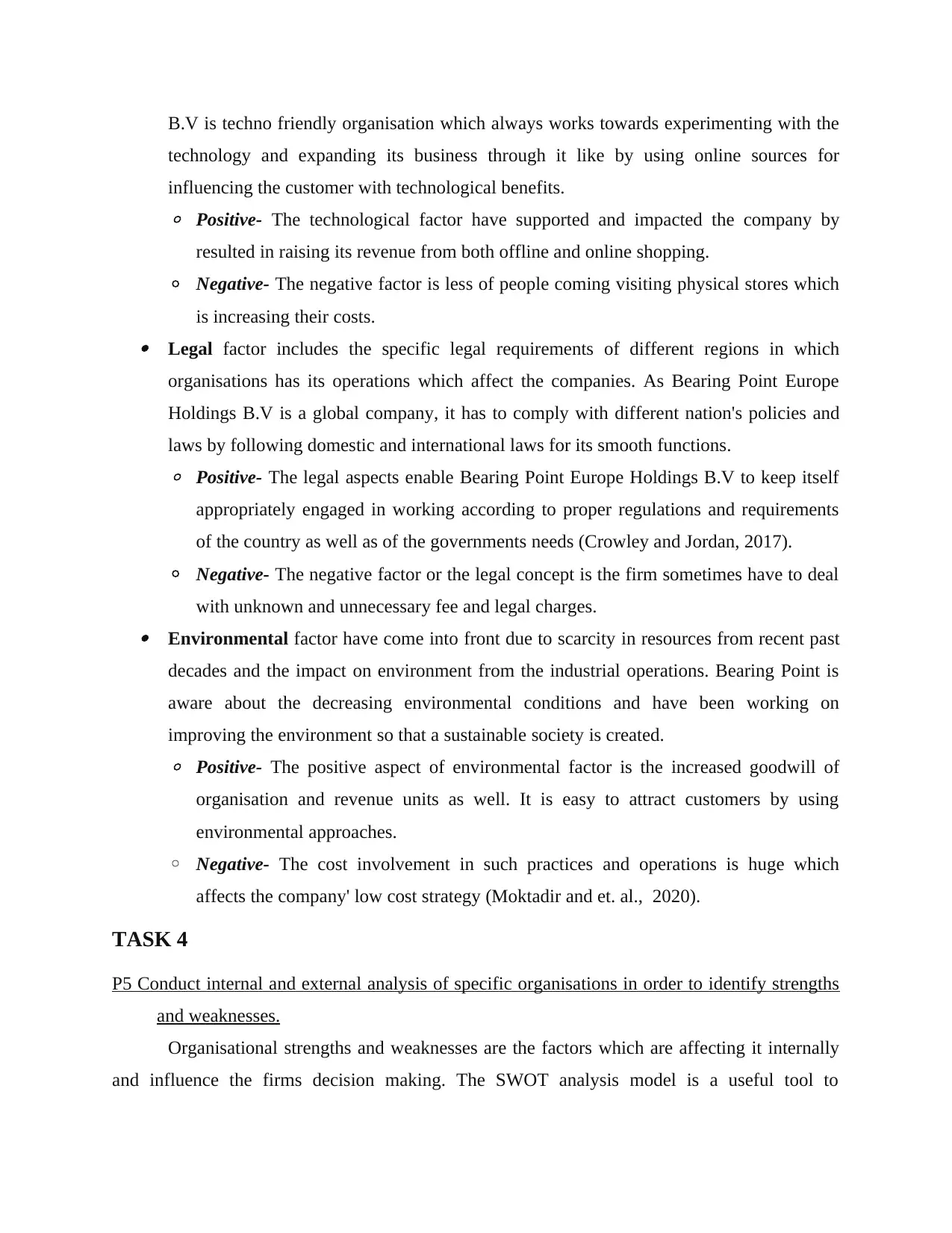
B.V is techno friendly organisation which always works towards experimenting with the
technology and expanding its business through it like by using online sources for
influencing the customer with technological benefits.
◦ Positive- The technological factor have supported and impacted the company by
resulted in raising its revenue from both offline and online shopping.
◦ Negative- The negative factor is less of people coming visiting physical stores which
is increasing their costs. Legal factor includes the specific legal requirements of different regions in which
organisations has its operations which affect the companies. As Bearing Point Europe
Holdings B.V is a global company, it has to comply with different nation's policies and
laws by following domestic and international laws for its smooth functions.
◦ Positive- The legal aspects enable Bearing Point Europe Holdings B.V to keep itself
appropriately engaged in working according to proper regulations and requirements
of the country as well as of the governments needs (Crowley and Jordan, 2017).
◦ Negative- The negative factor or the legal concept is the firm sometimes have to deal
with unknown and unnecessary fee and legal charges. Environmental factor have come into front due to scarcity in resources from recent past
decades and the impact on environment from the industrial operations. Bearing Point is
aware about the decreasing environmental conditions and have been working on
improving the environment so that a sustainable society is created.
◦ Positive- The positive aspect of environmental factor is the increased goodwill of
organisation and revenue units as well. It is easy to attract customers by using
environmental approaches.
◦ Negative- The cost involvement in such practices and operations is huge which
affects the company' low cost strategy (Moktadir and et. al., 2020).
TASK 4
P5 Conduct internal and external analysis of specific organisations in order to identify strengths
and weaknesses.
Organisational strengths and weaknesses are the factors which are affecting it internally
and influence the firms decision making. The SWOT analysis model is a useful tool to
technology and expanding its business through it like by using online sources for
influencing the customer with technological benefits.
◦ Positive- The technological factor have supported and impacted the company by
resulted in raising its revenue from both offline and online shopping.
◦ Negative- The negative factor is less of people coming visiting physical stores which
is increasing their costs. Legal factor includes the specific legal requirements of different regions in which
organisations has its operations which affect the companies. As Bearing Point Europe
Holdings B.V is a global company, it has to comply with different nation's policies and
laws by following domestic and international laws for its smooth functions.
◦ Positive- The legal aspects enable Bearing Point Europe Holdings B.V to keep itself
appropriately engaged in working according to proper regulations and requirements
of the country as well as of the governments needs (Crowley and Jordan, 2017).
◦ Negative- The negative factor or the legal concept is the firm sometimes have to deal
with unknown and unnecessary fee and legal charges. Environmental factor have come into front due to scarcity in resources from recent past
decades and the impact on environment from the industrial operations. Bearing Point is
aware about the decreasing environmental conditions and have been working on
improving the environment so that a sustainable society is created.
◦ Positive- The positive aspect of environmental factor is the increased goodwill of
organisation and revenue units as well. It is easy to attract customers by using
environmental approaches.
◦ Negative- The cost involvement in such practices and operations is huge which
affects the company' low cost strategy (Moktadir and et. al., 2020).
TASK 4
P5 Conduct internal and external analysis of specific organisations in order to identify strengths
and weaknesses.
Organisational strengths and weaknesses are the factors which are affecting it internally
and influence the firms decision making. The SWOT analysis model is a useful tool to
⊘ This is a preview!⊘
Do you want full access?
Subscribe today to unlock all pages.

Trusted by 1+ million students worldwide
1 out of 20
Related Documents
Your All-in-One AI-Powered Toolkit for Academic Success.
+13062052269
info@desklib.com
Available 24*7 on WhatsApp / Email
![[object Object]](/_next/static/media/star-bottom.7253800d.svg)
Unlock your academic potential
Copyright © 2020–2025 A2Z Services. All Rights Reserved. Developed and managed by ZUCOL.




